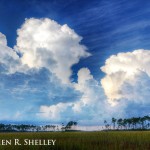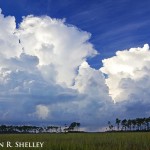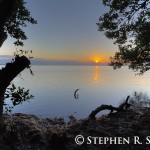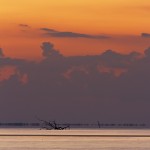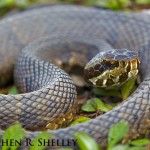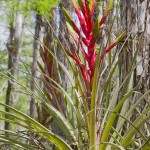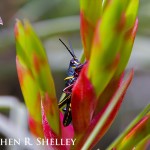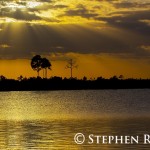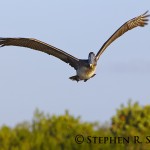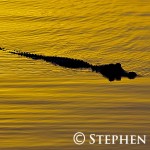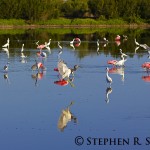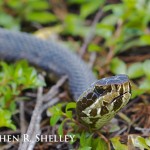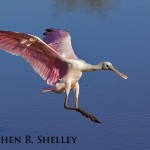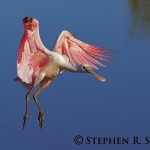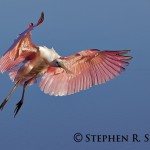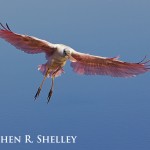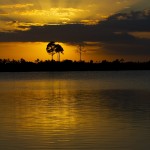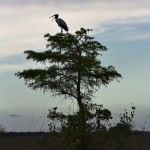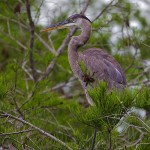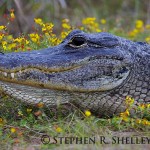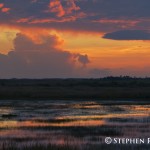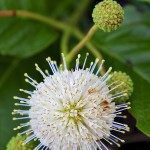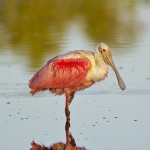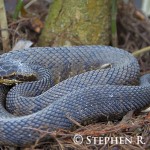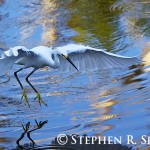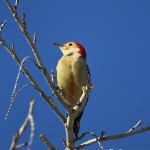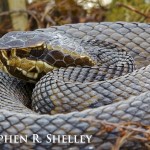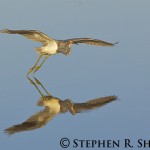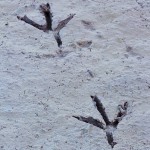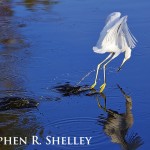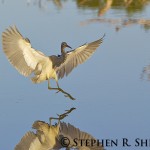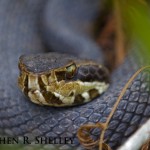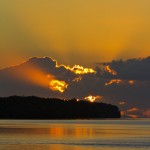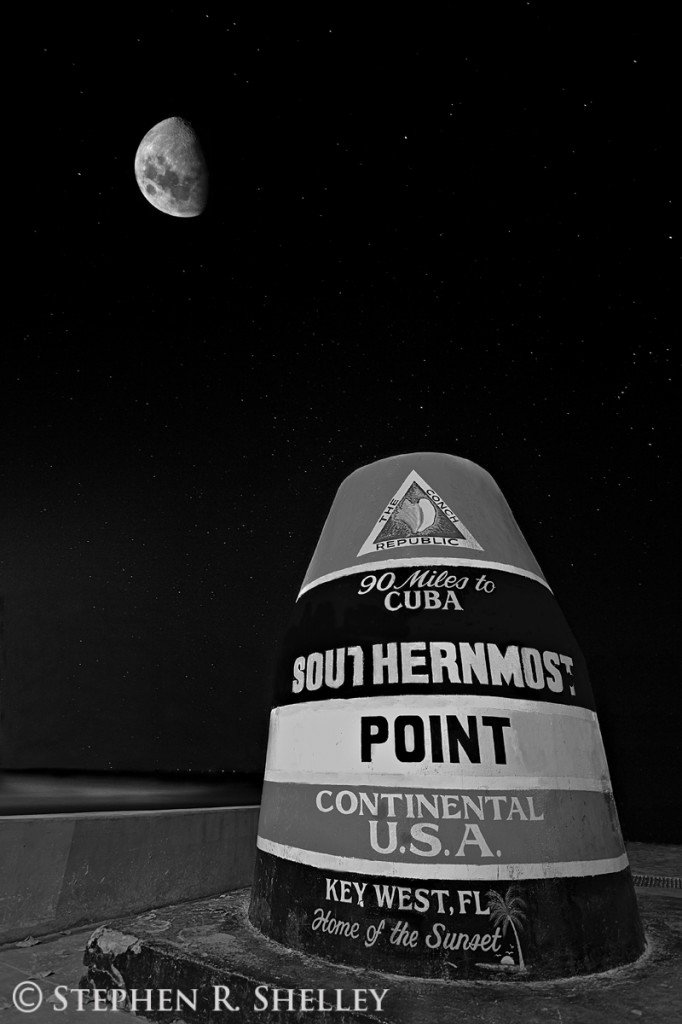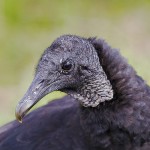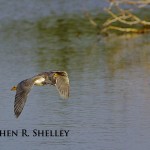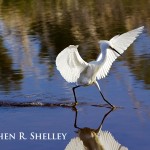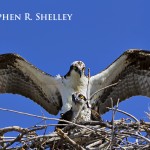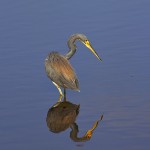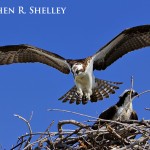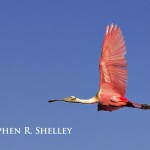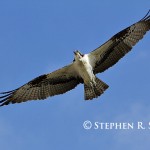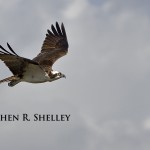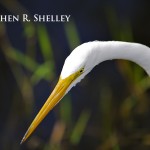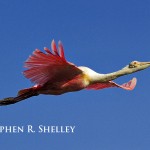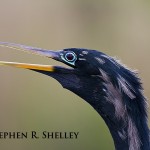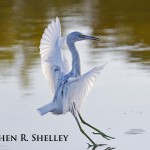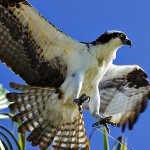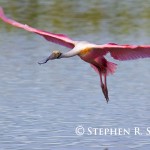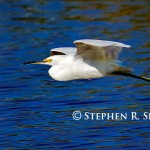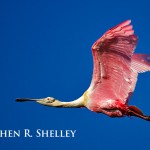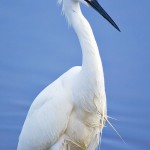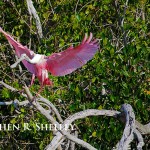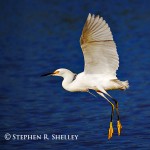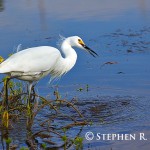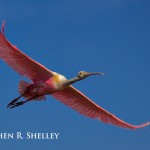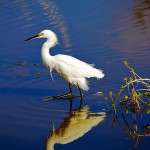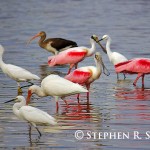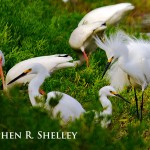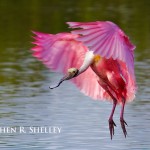After shooting a sunset one morning I noticed some building clouds on the drive home. I decided to pull over and watch them for a little while to see if they continued to build. After about 15 minutes or so they continued to climb skyward and then started producing some rain. They never did produce lightning or thunder but still made for some dramatic skies over the sawgrass prairies. I also decided to try an HDR shot of the storm in order try and capture the dynamic range of the clouds.
Christian Point Trail Everglades National Park Sunrise
Planned a trip to Christian Point Trail with a photographer friend of mine this week. We decided to try and capture a sunrise from the end of the trail overlooking snakebight. Unfortunately, this required leaving the house at 4:45 AM in order to get to the trail head by 5:45 AM. The hike to the end of the trail takes about 45 minutes and since we were making this trip in the dark we left ourselves a little extra time for any wrong turns or unforeseen events.
Christian Point is a 1.8 mile hike through varied terrain and ending at the waters edge overlooking Snake Bight. The shoreline faces due West making this an ideal sunrise location. The trail starts by going through a mangrove forest before opening up into a small marl prairie. After the first marl prairie you enter a large hardwood hammock where the trees are covered with epiphytes such as bromeliads, orchids and wild pineapples. The hardwood hammock eventually thins out and the trail emerges into a large marl prairie that is about .5 miles long and full of dead buttonwood trees from past hurricanes. At the end of the prairie is another thin clump of mangrove trees ending at the waters edge.
Unfortunately, the shoreline is densely covered in Mangroves leaving little in the way of options for choosing a photography location. One is limited to the opening at the end of the trail. The sunrise view is great however the composition options are limited. I was able to get an OK shot using the surrounding mangroves trees and overhanging branches silhouettes to frame the sunrise. In order to accomplish this I had to use a wide angle lens causing the sun to look small in the picture. I did take a few with a long lens before the sun came up but quickly realized the sun was going to rise away from the subject I had chosen in the distance.
I did not have time to explore to see if other openings existed farther down. I will try to plan a return trip when I am not in a hurry.
I found Christian Point Trail in Everglades National Park to be one of the more interesting designated trails in the park. The varied landscape created multiple photographic subjects. One could do landscape shots in one area and then switch to macro or plant specific shots in another. I also saw a good number of raptors flying overhead or perched on the dead buttonwood trees. However, be warned that the mosquitoes can be very thick in the mangrove and hardwood hammocks. When I was there they were not to bad but the temperature was in the 60’s in the morning. As the temperature started to warm up they started to become more plentiful.
I do not know if I would hike the trail again only for a sunrise as I think there are better sunrise locations within the park that do not require as much work to shoot. However, I will definitely return to Christian Point Trail for other photography subjects that are available on the trail.
Eco Pond, Cypress Dome and Pine Glades Lake Sunset
Had a free day and decided to get up early and head down to Everglades National Park. I decided to start at Eco Pond in the morning to see if the birds were active and then work my way back north. Today was a good bird day. Eco Pond was full of Roseate Spoonbills, Snowy Egrets, Great Herons, Tri-Color Herons, Pelicans and the ocassional overflying Osprey. They were also very active foraging around in the shallow water for fish and other food. One thing I noticed was how low the water in Eco Pond had gotten since my last visit. The East Side of the pond is almost completely dry. I got a few good shots of some landing Roseate Spoonbills. The one I captured was a juvenille spoonbill.
After the birds left Eco Pond I walked around and found a some osprey nests but they were not very active. I left Flamingo and started heading back north. My next stop was Snake Bight. I brought my bike and rode the path down to the end of the trail. I saw a few birds along the way but nothing motivated me to stop and get out my camera. At the end of the trail is a boardwalk. The tide was out exposing a large mudflat. A few birds were around but nothing better than I had already shot. I did note that this might be a good sunset location and may come back to try it out before summer officially arrives.
After Snake Bight I stopped by Mahogany Hammock to look for some barred owls but not were willing to show themselves. I kept driving north to a Cypress Dome I found a few weeks back. I hiked into the Dome and took some photos of the blooming Bromeliads. They were everywhere in the dome. I also came across the same water moccasins I saw during my last visit. One of the moccasins was not very happy and tried to bite me. Luckily I was out of his reach. I still got a few good shots of him before I left.
My next stop was another cypress dome farther north called Movie Dome. Last time I hiked into it the water was still about a foot deep or so. This time it was completely dry except for a shallow pool in the middle of the dome. I walked around the dome but did not take any pictures this time.
My last stop was Pine Glades Lake for a sunset. I captured some sunrays that were streaming from the sun giving the shot a unique look. Pine Glades Lake is one of my favorite sunset locations in Everglades National Park. After the sunset I headed home. On the way home I got a suprise panther sighting. This was my first panther sighting since I started coming to the park almost 8 years ago. The panther was walking the main park road and slipped into the bushes when he saw me coming. It was too dark to try and use the camera but it was still great to witness a free roaming panther.
Everglades Crazy Flower, Alligator and Sunset
Thanks to the time change, after I got off work on Friday I was able to run out to Everglades National Park to explore a trail I had not been to in some time. Unfortunately, the weather conditions were not ideal for photography, very overcast and cloudy. This made bird in flight and wildlife action shots very difficult. Also, my primary purpose was to capture a sunset and the storm clouds were blocking the sun completely.
The bright side to the bad conditions is that it made me slow down and look hard for photography subjects. I managed a few decent shots as a result. My favorite was a crazy flower I found growing on the side of the trail. I had never seen anything like it before and it kept me entertained for a little while. In the end I did get an ok sunset shot with lots of color but it was not what I was looking for out of that particular venue. The sun in the photo is off he frame to the right and behind a dark storm cloud. I just captured the side lighting from it.
Everglades Sunrise, Birds in Flight and Cypress Dome Walk
I went out last week to capture a sunrise down in Flamingo, Florida. I took a few reflection pictures across the water as the sun came up. After the sunrise I went to Eco Pond to try and capture some bird in flight pictures. The birds have started to thin out after reaching a peak a few weeks ago. There were still a good number of Roseate Spoonbills, Egrets, Heron’s and other birds but not like there had been the last few weeks. I ended up with a few I liked.
After the birds stopped performing, I started heading back toward the park entrance. I made one last stop to explore a cypress dome I had never walked into before. It was a great find and I plan on going back to try and take more pictures there in the future. Inside the cypress dome, I found resident gators, birds, and three water moccasins. I also found numerous orchids of different varieties including some very large and rare cigar orchids.
Key West Southern Most Point by Moonlight
I was in Key West this past weekend for my wife’s birthday. I brought my camera equipment but was to busy most of the time to take any pictures. However, I did have one shot I wanted to try while I was there. I wanted to try and capture the Southern Most Point Marker at night with the stars and moon behind it.
I scouted the location the first night I was there to check on the moon angle and contemplate the shot. I also found that even at 10:00 PM there were still people taking tourist shots in front of the marker. I came back the second night a little later to see if I could limit the chances of having a crowd to contend with. No such luck. New people arrived about every 5-10 minutes so I had to keep resetting my shot between groups.
The other problem I had was that the marker is located on the corner of two intersecting streets. In order to capture the stars in the background I was shooting 20 -30 second exposures. Inevitably within that time frame a car would come down the road and cause blowouts on the marker from the headlight reflections. It took a few tries before I could get a usable shot. I never could get a perfectly clean shot. I also had to take a few shots specifically for the moons exposure and then combine the two photos together. I used my Canon 10-22 to capture the Southern Most Point Marker and stars and my 70-200 to capture the moon in more detail.
All in all I am happy with the outcome. I just need to do a test print to see how it looks printed. I have found that star pictures are less dramatic when they are not back-lit by a computer monitor. Also, the stars standout in the high resolution shot more than the web upload shot used for this blog. In the photo below it only looks like there are a handful whereas the high resolution version probably has around 100 stars visible.
Canon 70-200 IS f2.8 ii with 1.4xIII Test Shots
Here a few of the test shots I took with my new Canon 70-200 IS f2.8 ii with 1.4x III teleconverter. I got up early and headed down to Eco Pond to test out my new lens. Unfortunately, it had been hotter than normal and there were not as many birds as usual at Eco Pond. The birds that were there also left early due to the heat. Either way I was still able to get a few good shots, however some of them were taken in the early morning sunlight requiring a higher ISO than I would have liked. These were test shots anyway.
I also got lucky and found an active osprey nest to entertain me once the other birds had departed. The low resolution uploads do not do this lens combination justice.
Canon 70-200 IS f/2.8 ii + Teleconverter
For the most part, I have primarily focused on landscape photography of the Everglades, Big Cypress, Florida Keys and South Florida. However, I received many requests for bird photos or bird in flight photos rather than strictly landscapes. During my last photography trip to the Everglades I spent some time trying to photograph birds in flight at Eco Pond (see prior blog post). I enjoyed the experience but also learned that I needed a better and longer lens if I was going to capture photos that I deemed to be acceptable for printing and selling. At the time all I had was my Canon 55-250 Kit Lens.
I have been contemplating purchasing a new long lens for sports/action/birding/wildlife for some time. The holdup has always been what to buy. I have used a friends Canon 100-400 on a few occasions and was for the most part happy with the results. However, I was not thrilled with the push/pull design and found the images to not always be as sharp as I would have liked. I kept hoping for an announcement by Canon of a new version but so far no new model has been announced.
I happened to be searching the Internet for opinions as to alternative choices and came across recommendations for the Canon 70-200 IS f/2.8 ii paired with either a 1.4x III or 2x III teleconverter. I thought this might be a good choice for me while I was waiting for the new 100-400 to eventually come along. It would give me a wider range when combined with the teleconverter as well as the speed at 2.8 when not paired with the teleconverter. I knew the Canon 70-200 IS f2.8 ii by itself was almost as sharp as a prime based on the many reviews I had read when it came out. My only question was how is the image quality when paired with a teleconverter and what was the effect on the auto focus speeds? To find out I spent countless hours pouring over reviews, blogs, forums and sample images. I can honestly say I have read almost every post ever made regarding the use of teleconverters on a Canon 70-200 IS f2.8 ii lens and probably looked at almost every sample image.
From my research I derived the following consensus. This consensus is based on the numerous reports, blog entries and forum posts that I have read and not my personal experience.
1. If you own a full frame camera then either the 1.4x or 2x III will produce sharp image quality and maintain usable auto focus speeds for most subjects. However, proper technique is key to be successful with the 2x III for both image quality and auto focus on moving subjects.
2. If you own a 1.6 crop sensor camera then the 1.4x will produce sharp images with very little if any loss of image quality and only a slight decrease in auto focus speed. The loss in auto focus speed does not seem to be noticeable in real world applications and is fine for birds in flight and/or action sports.
3. If you own a 1.6 crop sensor camera then the 2x III will produce sharp images if used on a tripod when taking pictures of stationary objects or animals. It will not produce consistently great results when used handheld or when trying to take pictures of moving objects. It can still be usable handheld and/or with moving objects but the number of acceptable keepers will be significantly lower than with other 400 mm or greater lenses. This seems to be a result of the longer focal length due to the crop sensor 640 mm vs. 400mm when using a full frame camera. The extra focal length of the crop sensor makes any shake or camera movement more noticeable and the resulting image softer. The slowed auto focus serves to only amplify this result.
4. If you do a Google search for this subject and choose images instead of general search you will generally find that the majority of sharp images taken with a 1.6 crop sensor camera and the 70-200 is ii and 2x III will be of a stationary object or animal or slow moving object or animal.
5. The same Google search will generally show that any action shots taken with the 70-200 is ii and 2x III that are sharp will for the most part be taken with a full frame sensor and sometimes the 1.3 crop sensor.
6. Sharp images of action shots taken with the 70-200 is ii and 1.4x are equally taken with the 1.6 crop senor or full frame cameras.
Based on my research I opted to purchase the Canon 70-200 IS f2.8 ii and the 1.4x III teleconverter for my 1.6 crop sensor camera to use for birds in flight, action shots and general subject matter. This gives me an effective range with the 1.4x III teleconverter attached of (156mm to 448 mm at f/4).
I took delivery of the lens and teleconverter combination last Friday and was up bright and early the next morning to test it out. From my limited use I can say that I am very happy with this lens and the 1.4xIII teleconverter. On the computer screen I could not tell the difference between shots take with the 1.4x III teleconverter and those taken without in regards to image quality. I also did not notice any difference in the auto focus with the teleconverter vs. without the 1.4x IIII teleconverter for birds in flight in real world conditions. I highly recommend this lens combination to anyone looking for a 400 mm range zoom lens assuming your have a crop sensor body.
I also borrowed an older model 2x teleconverter from a friend and did some back yard tests on stationary objects to test the image quality. Again, there was very little difference between the images with the 2x teleconverter and those without. I did notice a significant slowing of the auto focus that would likely pose some problems in real world applications for birds in flight or other actions shots. Unfortunately, I did not get a chance to test the 2x teleconverter on any moving subjects this time. However, I will eventually purchase a 2x III for those times I need the extra reach for stationary animals or objects once my budget allows for the additional purchase.
I will post some pictures I captured on Saturday in another follow up blog post.
Eco Pond Everglades National Park
I am not much of a bird photographer opting to primarily focus on Landscapes and Nature shots in general. However, I had someone request a Roseate Spoonbill in flight/action shot so I decided yesterday to give birding a try. I have never tried to capture birds in flight before but was excited for a new challenge. I checked the weather, got up early and headed to a place called Eco Pond to see if the Roseate Spoonbills were active.
Eco Pond is a very shallow (primarily less than 1 foot) pond with an island in the middle of it. Birds of all types love this spot to wade and feed in the shallow water and along the shorelines. There are even some nesting Ospreys that occupy one of the taller trees on the island.
Yesterday, the pond was full of activity with more than 100 hundred birds actively feeding or flying. There were probably more than 25 Roseate Spoonbills which at least gave me a good statistical chance of getting the shot I had come here for. I took about 150 shots and ended up with about 20 decent photos. I got a few good Roseate Spoonbill in flight shots but had to crop them to get what I was looking for. I will be test printing them to see if they will work or if I need to try again next week. Either way I had a good time and learned a lot about capturing birds in flight. It also made me realize I need to invest in some new glass if I am going to start shooting birds or wildlife on any consistent basis. My equipment is primarily geared toward things that are standing still and do not get frightened if you get close to it. These shots were taken with the Canon 55-250 Kit Lens.
Art South of Homestead Exhibit Extended
By popular demand my Exhibit at Art South of Homestead has been extended for an additional month. If you did not have a chance to see it last month you have another opportunity to come out and see my photography during the month of February.
On February 11, 2012, Art South will host their Second Saturday event and introduce the artists on display for the month of February. There will be free food and drinks. I invite everyone to come out and enjoy the festivities and meet the artists.
